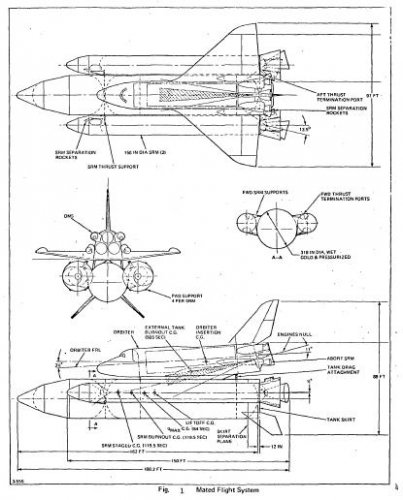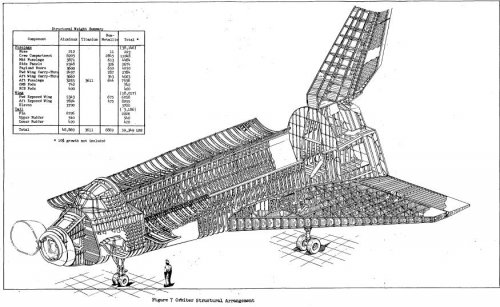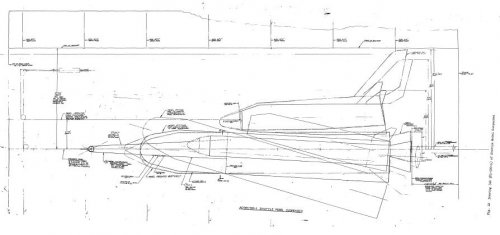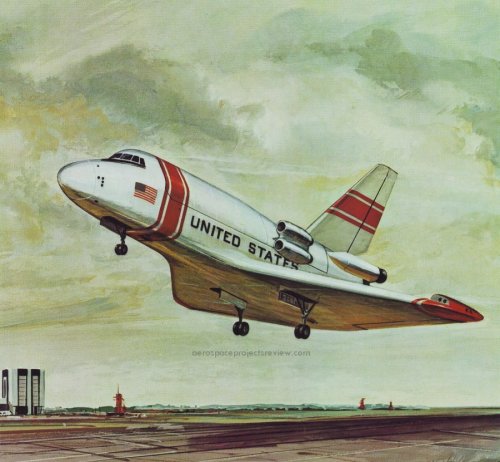You are using an out of date browser. It may not display this or other websites correctly.
You should upgrade or use an alternative browser.
You should upgrade or use an alternative browser.
Grumman G-619 space shuttle
- Thread starter hesham
- Start date
The intertank crossbeam for the forward SRB attach point looks interesting. It appears to pass horizontally between the LOX and LH2 tanks without going through the central axis of the intertank. Seems like a more efficient use of space than the final Shuttle ET.
I don't have my copy of the Jenkins book handy, but how close did Grumman come towards winning the shuttle orbiter contract? NAA's win likely had to do with its X-15 and Apollo CSM experience, plus its experience building large, high-speed aircraft like the XB-70. But my impression was that Grumman put together an extremely strong proposal (and its Apollo LM experience certainly didn't hurt.)
I don't have my copy of the Jenkins book handy, but how close did Grumman come towards winning the shuttle orbiter contract? NAA's win likely had to do with its X-15 and Apollo CSM experience, plus its experience building large, high-speed aircraft like the XB-70. But my impression was that Grumman put together an extremely strong proposal (and its Apollo LM experience certainly didn't hurt.)
Nik
ACCESS: Top Secret
- Joined
- 15 July 2009
- Messages
- 1,269
- Reaction score
- 1,063
IIRC, urban legend held that Grumman's lunar lander was so late that they were side-lined there-after...
Of course, building the lander meant Grumman had *learned* how to drag a reluctant project kicking & screaming to the pad, so may have done a much better job of delivering a practicable Shuttle.
Any truth to this ??
Of course, building the lander meant Grumman had *learned* how to drag a reluctant project kicking & screaming to the pad, so may have done a much better job of delivering a practicable Shuttle.
Any truth to this ??
- Joined
- 26 May 2006
- Messages
- 34,917
- Reaction score
- 15,790
Attachments
hesham said:
First thing I thought when I saw this was 'Coastguard colors??'
- Joined
- 26 May 2006
- Messages
- 34,917
- Reaction score
- 15,790
Brickmuppet
ACCESS: Secret
Nothing wrong with that, it is actually pretty logical.
GPS satellites, the stars the moon and planets are all in space.
And what are they?
They are aids to navigation.
This is a USCG responsibility.
So the livery is perfectly appropriate for an orbital buoy tender.
GPS satellites, the stars the moon and planets are all in space.
And what are they?
They are aids to navigation.
This is a USCG responsibility.
So the livery is perfectly appropriate for an orbital buoy tender.
PMN1 said:First thing I thought when I saw this was 'Coastguard colors??'
First thing I thought when I saw this was "What the hell did they paint this with such that it survived re-entry on the underside and leading edges without so much as a scorch mark, and can I get some of that paint and what sort of trouble can I create with it?"
- Joined
- 26 September 2008
- Messages
- 1,960
- Reaction score
- 746
Nik said:IIRC, urban legend held that Grumman's lunar lander was so late that they were side-lined there-after...
Of course, building the lander meant Grumman had *learned* how to drag a reluctant project kicking & screaming to the pad, so may have done a much better job of delivering a practicable Shuttle.
Any truth to this ??
Just saw this. There are a couple of projects in the works that will shed a lot of light on the rejection of Grumman's shuttle proposal. David Onkst has been working on a history of engineers at Grumman during Apollo and the early shuttle years. He has a lot of information on that subject, although he comes at it from a labor history perspective. He's still looking for a publisher, but his manuscript is nearly done.
John Logsdon has a book on Nixon's space policy and the shuttle decision that is currently with the publisher and I think is due out next year. It has a lot of information on how Nixon influenced the decision. A couple of relevant points: Nixon was very concerned about aerospace unemployment in California, so his people seemed to be very interested in the contract going there. And at least one analyst involved in some of the decision making thought that North American was a shoe-in because they had the most experience and the best proposal.
Grumman had experienced some management turmoil (see the F-14 contract issues), and supposedly it was management weakness that caused them to lose. The Grumman people thought they had the best technical proposal, but of course they were biased.
From talking to both Onkst and Logsdon, and my reading of their material, it seems like NAA/Rockwell did put in a solid proposal, possibly the best, but that Nixon also wanted the contract to go to a California company. So even in a totally fair fight, Rockwell probably would have won.
http://history.nasa.gov/SP-4221/ch9.htm
Grumman actually gained the highest score in the technical areas. Its configuration was not perfect, with Fletcher noting "complex designs" in guidance, control, navigation, and data processing. He, however, wrote that "Grumman's design went to a greater depth of detail than those of the other companies. Its detailed weight estimates were substantiated by the design details." Its structural layouts showed "a thorough understanding of potential problems and positive solutions," and were simple and straightforward. [431] "Grumman did a very good job in proposing design features to enhance maintainability," he added. "The provisions it made for access throughout the vehicle were outstanding."
Grumman, however, was less outstanding in cost and management. Its proposed cost was higher than NASA liked. Fletcher saw why: the firm planned "to build up its work force rapidly to an early manpower peak. This poses the risk of premature hardening of the specifications and premature commitment of resources during the course of the program." Grumman came in a strong second overall; its excellent design did not outweigh its shortcomings in these other areas.
Similar threads
-
-
Grumman Space Shuttle : Design 518 & 532 to H-33
- Started by hesham
- Replies: 29
-
-
-




